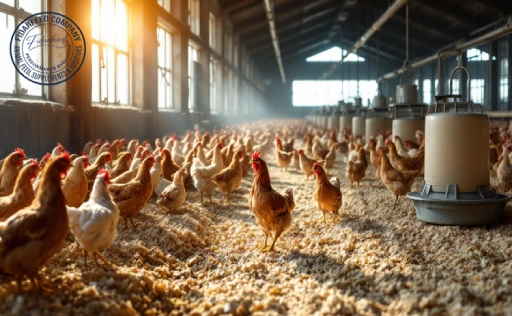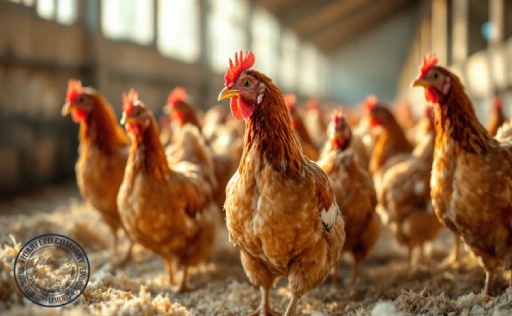
Internal Parasites in Sheep are one of the most stubborn and costly challenges that sheep breeders face. Whether you’re just starting with a small flock or managing hundreds of animals, parasites can quietly undermine everything you’re working for—health, productivity, and profitability. The good news? With the right knowledge and approach, you can take charge before they take over. In this guide, we’ll walk through practical, science-backed solutions that are easy to implement and proven to work. So let’s dig in and help you protect your flock.
What Are Internal Parasites in Sheep and Why Should You Care?
Internal parasites are organisms that live inside the sheep’s body—mostly in the digestive system—and feed off their nutrients. The most problematic ones damage the stomach and intestines, weakening the immune system and reducing growth, wool quality, and especially egg-laying and milk output in breeding ewes.
Learn more about: Active Probiotic Yeast for Large animal
These parasites may be microscopic, but their impact is massive. A study from the University of New England (Australia) showed that infected sheep can suffer a 30–50% drop in weight gain and up to 20% mortality if left untreated. For any farmer, that’s more than just numbers—it’s lost income, increased feed costs, and a whole lot of frustration. That’s why staying ahead of the curve is non-negotiable.
Common Types of Internal Parasites Found in Sheep
While several parasites affect sheep, some are more common—and more dangerous—than others:
-
Barber Pole Worm (Haemonchus contortus): The most notorious. It feeds on blood and can cause severe anemia and sudden death, especially in warm, humid climates.
-
Brown Stomach Worm (Teladorsagia): Damages the stomach lining, leading to poor digestion and reduced appetite.
-
Liver Flukes (Fasciola hepatica): Often found in wet areas, these damage the liver and compromise the sheep’s overall vitality.
Learn more about: Mitigating Heat Stress in Sheep: Practical Solutions
-
Tapeworms (Moniezia spp.): Generally less harmful, but still a concern in growing lambs due to reduced feed conversion.
Knowing what you’re dealing with helps you take targeted action, rather than just guessing.
How to Spot the Signs of Parasite Infestation in Your Flock
Internal parasites in sheep don’t always announce themselves loudly—until it’s too late. Watch closely for these signs:
-
Pale eyelids or gums (a classic sign of anemia)
-
Diarrhea or “scouring”
-
Weight loss or poor growth, even when feeding seems adequate
Learn more about: The Ultimate Guide to Sheep Farming Equipment
-
Bottle jaw (a fluid swelling under the jaw)
-
Decreased appetite
-
Wool damage from scratching or rubbing
Use the FAMACHA system—a simple tool that scores the color of a sheep’s lower eyelid—to monitor anemia levels and decide which animals need deworming. Many breeders swear by it because it’s quick, low-cost, and effective.
Proven Strategies to Prevent Internal Parasites in Sheep
Prevention is your strongest weapon. Here’s what works:
-
Rotate Pastures Frequently: Move your flock every 4–7 days during peak parasite seasons. This breaks the parasite lifecycle.
-
Avoid Overgrazing: Parasite larvae tend to live in the bottom 2 inches of grass. Don’t force sheep to graze that low.
-
Provide Clean Water and Feed: Dirty troughs can be breeding grounds for parasite eggs and larvae.
-
Mix Species on Pasture: Grazing sheep alongside cattle or goats can reduce parasite loads, as most parasites are host-specific.
-
Selective Breeding: Choose rams and ewes with natural resistance. Some sheep breeds, like Katahdin, show strong parasite resilience.
These strategies don’t just reduce parasite risk—they improve overall pasture health and productivity too.
Best Deworming Practices for Effective Parasite Control
Dewormers (anthelmintics) are vital tools—but only when used correctly. Here’s how to make the most of them:
-
Targeted Treatment: Deworm only those that need it, based on FAMACHA scores or fecal egg counts. Blanket deworming leads to resistance.
-
Rotate Drug Classes: Don’t use the same type repeatedly. Change every year or season to prevent parasite adaptation.
Learn more about: Dorper Sheep Farming: Producing High-Quality Meat for Maximum Profit
-
Dose Correctly: Under-dosing is worse than skipping treatment—it builds resistance. Always base dose on the heaviest animal in the group.
-
Check Efficacy: Do fecal egg counts before and 10–14 days after deworming to make sure it’s working.
The misuse of dewormers has led to global resistance problems. Smart use today preserves effectiveness for tomorrow.
Natural Alternatives and Supportive Remedies That Actually Work
Looking for gentler solutions? Several natural approaches show promise:
-
Garlic and Papaya Seeds: Some studies report moderate anti-parasitic effects, especially when combined with a clean diet.
-
Diatomaceous Earth: Mixed reviews, but it may help in dry feed to reduce worm burdens.
-
Tannin-rich Plants: Chicory, sericea lespedeza, and birdsfoot trefoil have shown effectiveness in reducing worm loads by disrupting parasite digestion.
-
Apple Cider Vinegar & Molasses Mix: A traditional remedy used in moderation to support general health and digestion.
Natural methods work best when used as a support, not a replacement, for science-based treatments.
Creating a Parasite Management Plan That Works for Your Farm
A parasite management plan should be tailored to your climate, flock size, and management style. Key steps include:
-
Set monitoring routines: Use FAMACHA or fecal tests monthly in warm months.
-
Record treatments: Track what was used, when, and the results.
-
Involve your vet: Build a relationship with a local vet or livestock specialist who can help you interpret test results.
-
Educate your staff: Everyone handling sheep should recognize signs and understand protocol.
Learn more about: How to Treat Ringworm in Sheep and Lambs: A Complete Guide
With a plan in place, you’re not just reacting—you’re leading.
Common Mistakes in Controlling Internal Parasites—and How to Avoid Them
Even experienced breeders slip up. The most frequent errors include:
-
Overusing dewormers: This accelerates drug resistance and lowers treatment options.
-
Ignoring pasture conditions: Dirty, overgrazed fields are a parasite’s paradise.
Learn more about: The Essential Guide: How Do Sheep Help Farmers?
-
Skipping monitoring: Guesswork isn’t good enough. Use tools like FAMACHA or egg counts.
-
Not quarantining new sheep: Always isolate and deworm new arrivals before mixing them with your flock.
Learn from others’ mistakes and save yourself the stress (and cost).
Final Thoughts: Take Control of Internal Parasites Before They Control Your Flock
Internal parasites in sheep are a tough challenge—but not unbeatable. By understanding what you’re dealing with, using targeted treatments, rotating pastures, and investing in long-term strategies, you can dramatically reduce their impact. Your sheep will thrive, your farm will perform better, and your bottom line will thank you.
Got a tip or a question? Drop a comment below, share your experience, or ask for advice. Let’s learn and grow together—because healthy flocks mean stronger farms, and stronger farms mean a better future for us all.







